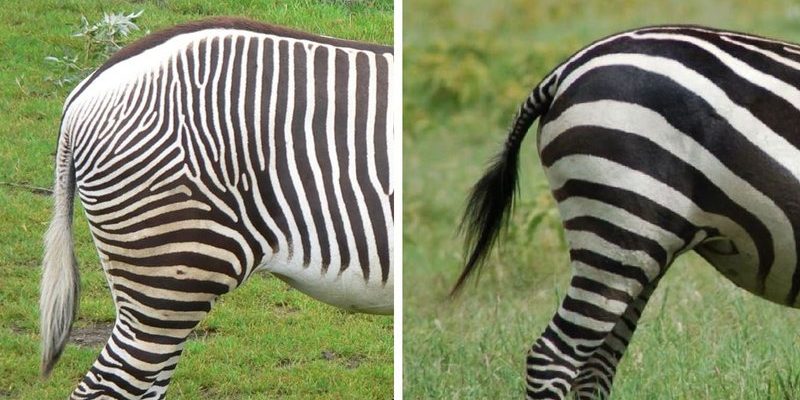![Comparing The Grevy’S Zebra Vs. [Similar Species]](https://gudri.com/wp-content/uploads/2025/06/Comparing_The_Grevy___S_Zebra_Vs___Similar_Species__image_0.jpg)
Let’s break it down by diving into the world of these stripes. The Grevy’s zebra is known for its striking appearance and is the largest of all zebra species. They have narrower stripes, which look like elegant brushstrokes on a canvas. On the other hand, the mountain zebra is a bit smaller and sports a different stripe pattern, along with a more robust build. So, what exactly sets them apart? In this article, we’ll explore their habitats, physical characteristics, social behavior, and what they eat, all while uncovering the fascinating world of these two zebras.
Physical Characteristics: What Makes Each Zebra Unique?
When we think about the **Grevy’s zebra**, the first thing that stands out is its size. These zebras can reach up to 5 feet tall at the shoulder and weigh between 700 to 1,000 pounds. Their stripes aren’t just for show; they help protect them from predators. The narrower, vertical stripes create an optical illusion that confuses predators when the zebras are in motion.
In contrast, the **mountain zebra** is typically smaller, averaging around 4.5 feet tall and weighing between 500 to 800 pounds. One notable feature about mountain zebras is their unique “gridiron” pattern on their rumps, which is different from the Grevy’s zebra’s more uniform stripes. Honestly, if you put these two zebras side by side, you’d immediately see how their stripe patterns and body shapes reflect their adaptations to different environments.
Think of it this way: if the Grevy’s zebra is like a tall, sleek athlete, the mountain zebra resembles a sturdy mountain climber—both strong but equipped for different challenges in the wild.
Habitat: Where Do They Call Home?
The **Grevy’s zebra** primarily roams the dry savannas and grasslands of East Africa, particularly in Kenya and Ethiopia. They need access to water sources and open spaces where they can graze freely. Their habitat choice reflects their need for large territories to roam, as they are used to traveling long distances in search of food and security.
On the flip side, the **mountain zebra** prefers the rugged terrain of the mountainous regions in southwestern Africa, especially in areas like Namibia and South Africa. They thrive in semi-arid environments with rocky outcrops where they can easily escape predators. Here’s the thing: these zebras have developed an impressive climbing ability, allowing them to traverse steep terrains that many predators can’t follow.
So, while the Grevy’s zebra is like a sun-loving nomad of the grasslands, the mountain zebra is the savvy climber, expertly navigating the highlands. Their choice of environments plays a huge role in shaping their daily lives.
Social Behavior: How Do They Interact?
Social dynamics among zebras can be quite fascinating. The **Grevy’s zebra** tends to be more solitary compared to its cousin. They often form small groups or hang out with their mothers and offspring. Males, known as stallions, can be quite territorial, usually defending their space against other males. You might find them engaging in dramatic displays of strength, like kicking or biting, to show dominance.
In contrast, **mountain zebras** are more social and often form larger herds, sometimes numbering in the hundreds. These herds provide safety in numbers, which is essential when it comes to keeping an eye out for predators. Within these groups, a hierarchical structure develops, where dominant stallions often lead while females work together to care for their young. It’s a bit like a community, supporting each other in the face of danger.
This difference in social structure highlights how each species adapts to their respective environments. While the Grevy’s zebra may prefer its independence, the mountain zebra thrives in a collaborative setting.
Diet: What’s on the Menu?
Both zebras are herbivores, but their diets reflect their habitats. The **Grevy’s zebra** primarily munches on grasses, but they also eat leaves and shrubs, especially in semi-arid regions where grass may be scarce. Their long, narrow mouths allow them to graze effectively, reaching for harder-to-access food sources, which can be a game-changer in tough environments.
Now, the diet of the **mountain zebra** is slightly different. They mainly feast on a variety of grasses, especially the tougher varieties found in their rocky habitats. What’s fascinating is their ability to extract moisture from the vegetation they consume. This adaptation is crucial for survival in areas where water is less accessible.
This dietary distinction is like the difference between a buffet and a gourmet meal. The Grevy’s zebra has a diverse plate, while the mountain zebra enjoys a more selective, hearty fare.
Conservation Status: Protecting the Striped Wonders
Sadly, both the **Grevy’s zebra** and the **mountain zebra** face challenges that threaten their survival. The Grevy’s zebra is classified as endangered due to habitat loss, poaching, and competition for resources with livestock. Their population has dwindled to only a few thousand remaining in the wild.
On the other hand, the mountain zebra is listed as vulnerable but is in a slightly better position due to conservation efforts in their habitats. National parks and reserves play a significant role in protecting them, ensuring they have the space to roam freely and safely.
It’s crucial to support conservation initiatives aimed at preserving these magnificent species. Just as every stripe on a zebra is unique, so too are the roles they play in their ecosystems. Protecting them means preserving the beauty of biodiversity.
When you step back and look at the **Grevy’s zebra** and **mountain zebra**, you find two remarkable animals that embody the diversity of nature. Each has adapted to its environment in unique ways—from their physical characteristics and social behaviors to their diets and conservation status.
Learning about these stripes allows us to appreciate the intricate web of life and the importance of protecting it. Next time you spot a zebra, take a moment to consider its story and the challenges it faces. After all, understanding these differences brings us one step closer to ensuring their future. Remember, every small effort counts when it comes to conservation!

